Moisture-resistant drywall: modern design in the bathroom - easy!
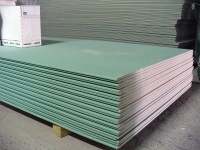
Not all experts advise the use of drywall sheets in the bathroom because of high humidity, but this opinion is erroneous. Moisture-resistant plasterboard can be used in the bathroom, because it has many advantages and is not affected by moisture. Installation work is quick and easy, as well as plasterboard is suitable for further painting or tiling with ceramic tiles.
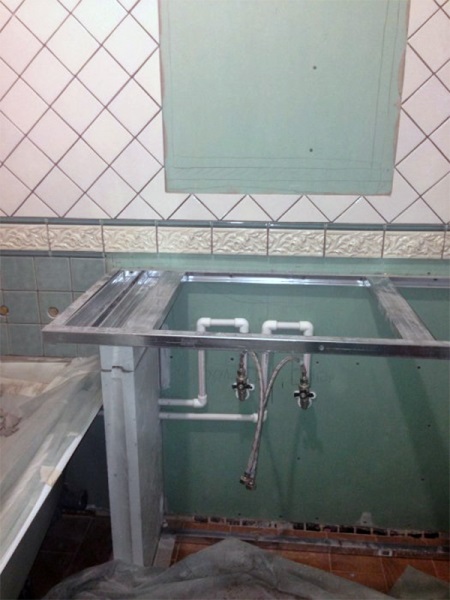
Characteristics
Gypsum plasterboard (abbreviated as KGLV) is a construction material, which is used in the bathroom for different purposes: alignment of walls or ceilings, creating additional partition walls, arches or walls in the rooms.
Plasterboard KGLV is impregnated with a special substance that protects the material from moisture and water penetration. Moisture-resistant gypsum board is very popular among buyers, because it has a low weight, it is easy to work with, as well as the material is environmentally friendly material. Gypsum plasterboard is sold in sheets that have standard sizes, which allows you to calculate the required amount of material before conducting construction or repair work.
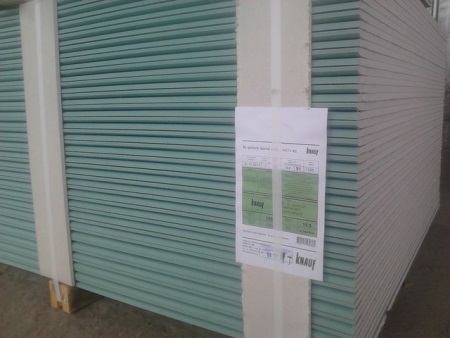
Depending on the degree of quality KGLV has two varieties:
- The highest group, labeled "A."
- The lowest group marked "B".
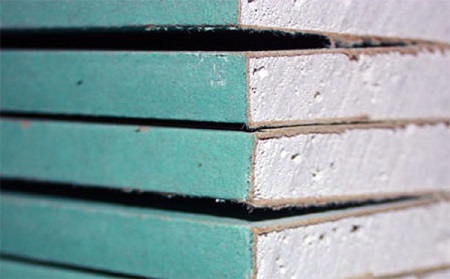
The production of plasterboard is engaged in many companies around the world, but the most popular are a few manufacturers, such as LafargeGroup (France), Gyproc (Finland) and Knauf (Germany). The pricing policy of the above companies is slightly higher than the usual price of the material, but the quality will please each buyer.
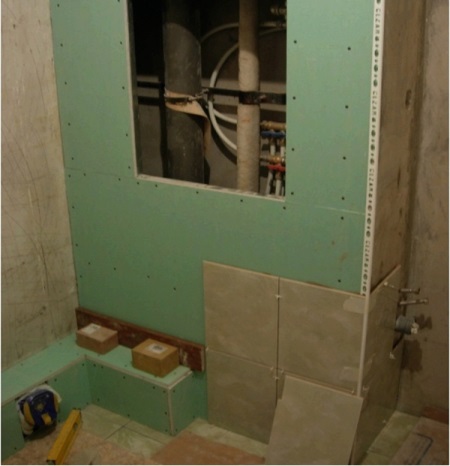
Typically, moisture-resistant gypsum board sheets are blue or green, but such coloring is not mandatory. Each manufacturer of KGLV can use its own marking.
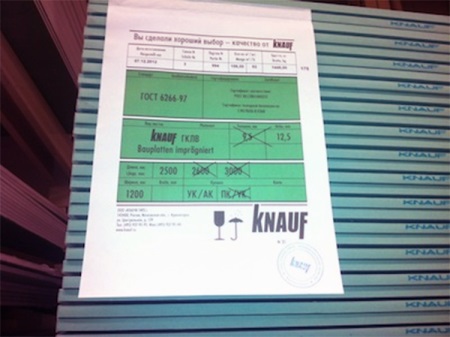
Types
The main types of drywall that are used for repair, construction and finishing work:
- wall plasterboard used for finishing walls. Experts do not recommend its use in dry rooms with high air temperature, as the material loses its strength and becomes brittle;
- ceiling KGL allows you to create a multilevel ceilings that perfectly emphasize the interior space. Suspended ceilings allow you to hide all the irregularities and save money on leveling the ceiling surface. Under the suspended ceilings is an excellent camouflage of wiring and it is easy to mount a variety of lighting systems;
- fireproof gypsum plasterboard refers to the universal material. It is often used for ceilings or walls in the bathrooms of wooden houses, where there is an increased risk of fires. For small rooms with high humidity, it is better to use moisture-resistant drywall, as the fire-resistant type absorbs moisture and begins to sag over time;
- moisture-resistant KGL is perfectly suitable for use in rooms with high humidity. On the surface of the moisture-resistant type, you can easily mount ceramic tiles or other finishing material;
- arch drywall is used to create arches, because it is characterized by high strength and flexibility. To create arches and walls with large curves, this type of material will be the best option.
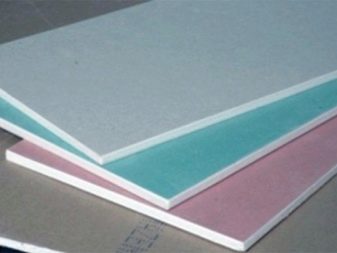
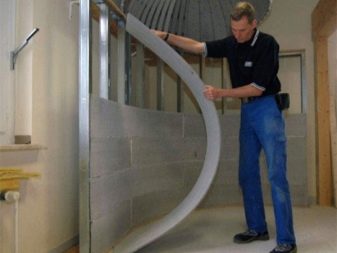
To level the walls or ceiling in the bathroom, you can use plaster and putty or plasterboard. Finishing the walls with plaster and putty will take a long time, requires skills and strict adherence to technology, after the work remains a lot of construction waste. Using gypsum board will help to quickly and easily make the alignment of the walls or ceiling. After fixing the gypsum board, you can immediately proceed to the finishing work and do not have to spend a lot of effort on the removal of construction debris.

Pros of
The advantages of moisture-resistant drywall:
- practicality;
- durability;
- it is not prone to fire, for example, if the wiring catches fire;
- is an environmentally friendly material, because it consists of paper and plaster and is impregnated with a special substance to protect against moisture and water penetration;
- good air permeability, which prevents the formation of fungus under the finishing materials;
- saving time on finishing work;
- gypsum plasterboard is capable of implementing any design solutions;
- is a good basis for painting or using ceramic tiles;
- excellent elasticity of the material allows to give any geometric shape
- low price of the material;
- installation of drywall is quick and easy.
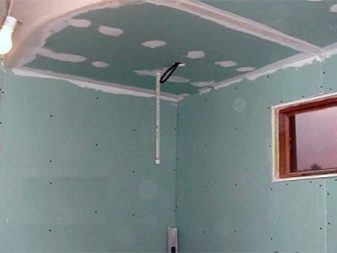
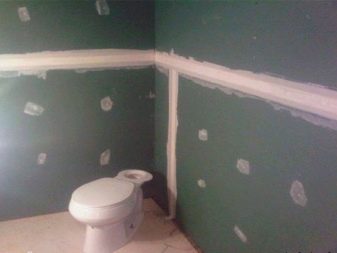
Disadvantages
The disadvantages are as follows:
- after the removal of the finishing material, it can not be reused;
- the material does not withstand strong impacts;
- you can not hang heavy objects on the plasterboard wall;
- sound insulation is very low, so you need to think about additional noise insulation.

Features of the ceiling installation
Mounting gypsum board is quite simple, even a novice without experience can independently perform installation work. It is necessary to adhere to a certain sequence of actions when creating a metal frame under the gypsum plasterboard sheets. First it is necessary to measure the room, create a drawing of all the structures and purchase all the consumables and prepare the tools. To create a metal frame, you must use a screwdriver drill.
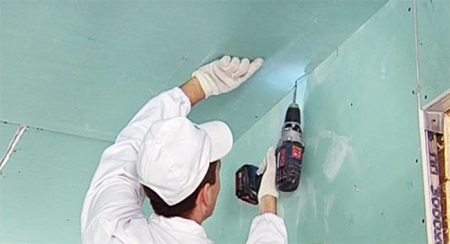
To install drywall sheets will require some tools, namely:
- level;
- safety glasses;
- Hacksaw, the thickness of the blade should be 1.8 cm;
- side cutters;
- electric jigsaw or scissors to work on metal;
- hammer;
- knife;
- pliers;
- tape measure, pencil and plumb line.
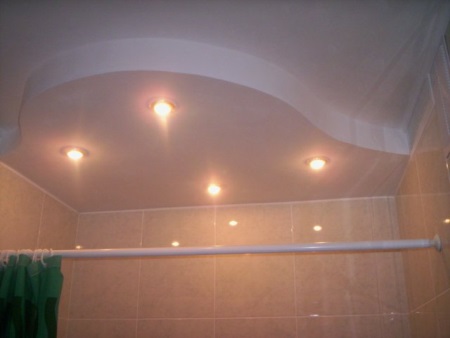
Materials that will be needed to finish the ceiling:
- sheets of moisture-resistant gypsum plasterboard;
- primer;
- metal profiles;
- self-tapping screws and dowels.
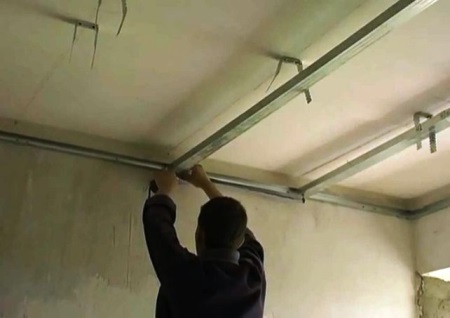
First, you need to wait some time before installing the moisture-resistant GPB so it can adapt to the temperature of the air in the room. This will prevent the sheets from deforming with temperature changes.
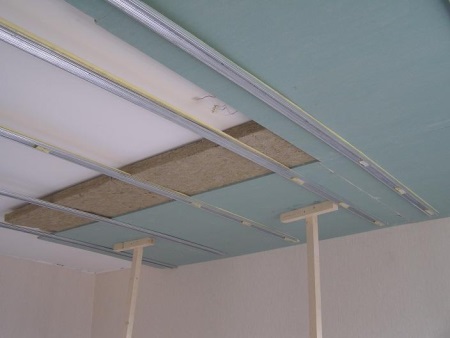
Installing the ceiling in the bathroom with a metal frame:
- It is necessary to install guide profiles on the ceiling, for this purpose, nail-dowels are used all around the perimeter. To check the evenness of the fasteners use a level or plumb line. Then attached mullion profile, to which the horizontal bars are attached. At this point, the installation of the frame is complete.
- It is necessary to hold all communications, and to determine in what places there will be openings in order to lay electrical wires. It is better to hide the communications in a corrugated tube to prevent possible fire or mechanical damage.
- The framework is clad with sheets of moisture-resistant gypsum plasterboard. Self-tapping screws are used to fasten the gypsum board. During installation, the sheets should adhere tightly to each other, and then it is necessary to close all the joints with reinforcing tape and treat with moisture-repellent putty. According to the same technology is processed all the corners. The use of sealant will create a reliable protection against high humidity in the bathroom. To strengthen the construction, two layers of sheets are used, with the second layer of plasterboard mounted on conventional glue. If the ceiling is mounted lighting, it is necessary to use only special moisture-resistant fixtures, which can be used in rooms with a high level of humidity.
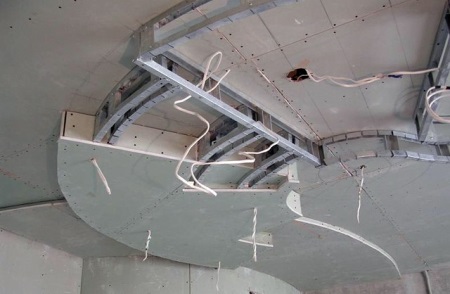
If the self-tapping screws do not sink into the drywall sheet, see the following video.
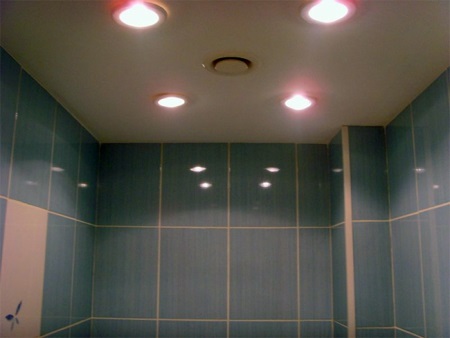
Installing a ceiling in the bathroom without using a metal frame:
- Preliminary ceiling preparation. First you must grout all potholes and cracks, then treat the ceiling and drywall sheets with primer to conduct a deep disinfection. The joints between the sheets should be masticated, which has water repellent properties.
- Special adhesive is applied to the ceiling and sheets with a roller or paint brush. Only moisture-resistant adhesive should be used. Then the sheets are glued to the ceiling and pressed tightly to the surface.
- For additional protection, all seams and joints should be treated with sealant.
- When the ceiling is completely glued with gypsum board, you can proceed to plastering with a special moisture-resistant mixture, tiling or painting.

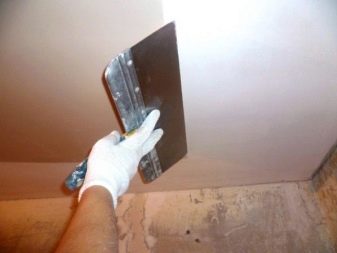
Wall finishing
Mounting gypsumboard sheets on the walls is carried out in the same way as on the ceiling, as well as the same tools and materials are used.
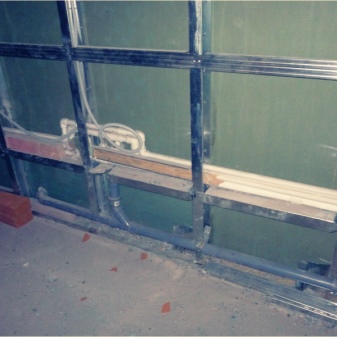
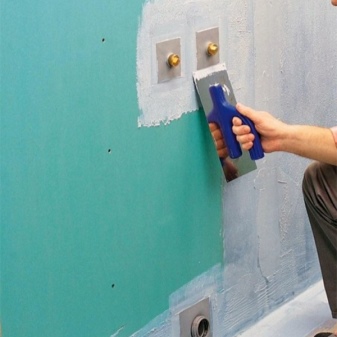
Finishing the walls of the bathroom KGL:
- First, it is desirable to make a leveling of the walls with a framework. If there is no such a possibility, the sheets of drywall can be attached immediately to the walls, but be sure to prepare them well in advance.
- It is necessary to create a reliable waterproofing around the perimeter of the room. All the edges of the waterproof drywall sheets should be treated with mastic or wrapped with a waterproofing membrane. Particular attention should be paid to those places where the connection will be made with the flooring or ceiling.
- To create a reliable resistance to moisture, each sheet should be treated one day before installation with a special water repellent.
- Seal each wall separately.
- Many experts recommend using a metal frame to avoid future problems. The framework will take a few centimeters of space, but in this gap you can hide all bathroom communications.
To create an original design, you can make the wall concave or convex. KGLV acquires the necessary shape quickly and easily enough.
Sequence of actions:
- Sheet of plasterboard should be well wet, give the necessary shape and leave for some time to dry. To moisten the sheet, it is better to use a roller with metal needles, then the moisture will get inside faster.
- Next, you need to cover the sheet with a damp cloth.
- When the sheet dries, you can repeat this procedure several times, which will completely prevent possible bends in the sheet.
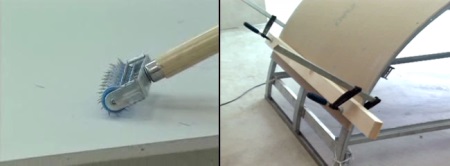
Plasterboard cladding
In the bathroom, different types of finishing materials can be used to finish surfaces created from sheets of moisture-resistant gypsum board:
- cork;
- ceramic tiles and mosaics;
- Paint and decorative plaster, but only moisture-resistant;
- special moisture-resistant wallpaper;
- plastic panels.
When choosing a finish, remember that the material used must not be afraid of high humidity in the bathroom. If you properly create a lining of walls and ceilings with plasterboard sheets, and remember about good ventilation, then walls, ceilings, partitions or niches will have a long service life.
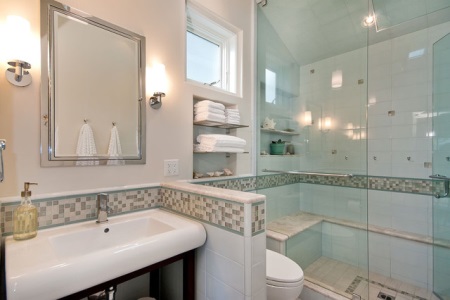
Countertops, shelves, screens for baths from drywall
Drywall in the bathroom is used not only for the walls or ceiling. It allows you to implement many design ideas and give the room originality. All the pipes can be hidden under the drywall, so that the unaesthetic communications were not visible. Since the pipes need constant access, you can make a window that will be covered by a special removable plastic plug.
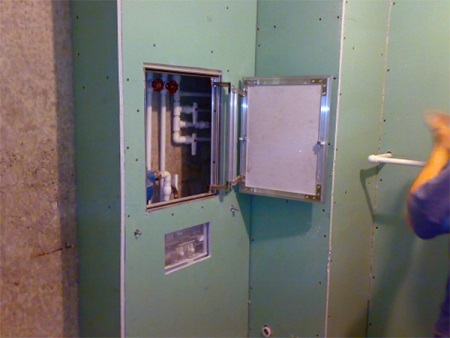
CGL can be used to cover the frame for the bathroom screen. Next, it can be tiled to create a cozy room. But you need to try not to let the water get behind the tub, because over time, the constant moisture will lead to deformation of moisture-resistant gypsum board sheets. Therefore, it is better to immediately think of a reliable waterproofing.
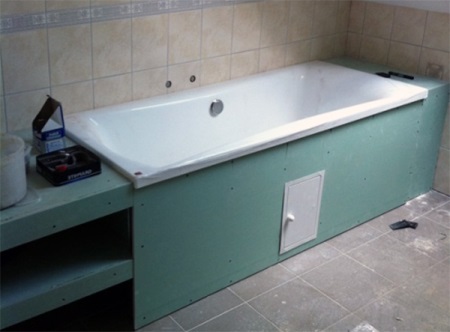
Shelves made of plasterboard are also very popular in the bathroom, where there are always a lot of cosmetics and household chemicals.
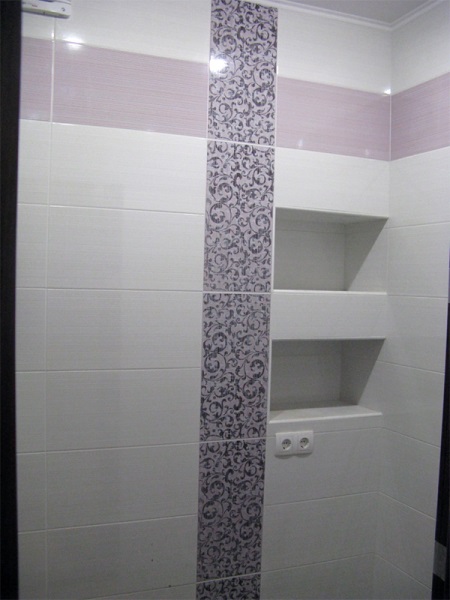
Tabletop of stone or MDF is quite expensive, so to save money you can make tabletop of CGL. In this case, you need to create a reliable waterproofing, using a finish of ceramic tiles, natural stone or mosaics, as well as a well-fixed sink.
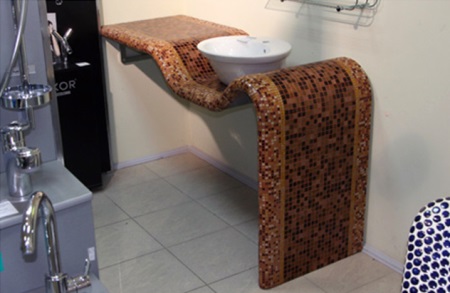
Niche from gypsum board will help to save bathroom space significantly, as well as create a unique interior.
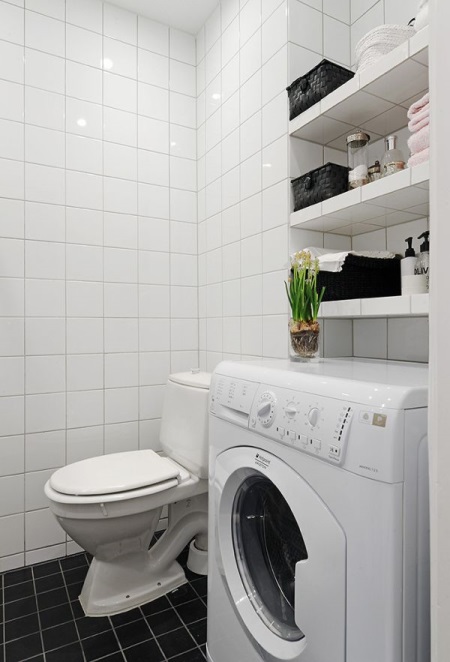





Using drywall closed all the pipes. Tiled. All perfectly!